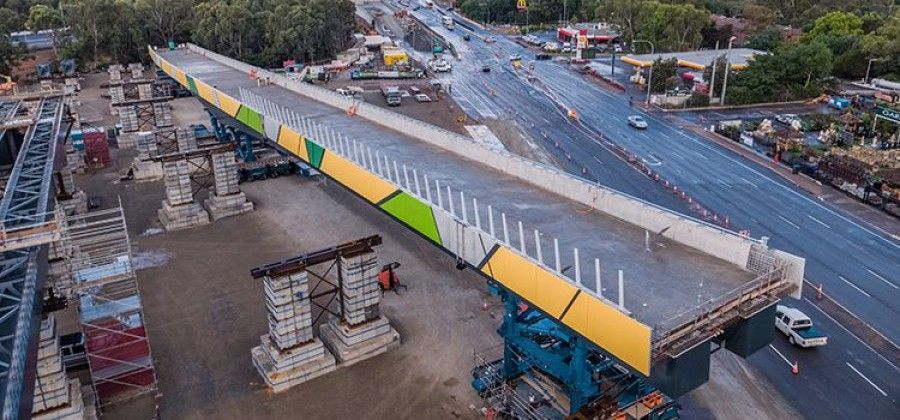The Darlington Upgrade Project is breaking new ground as it strives to build extensive new infrastructure specifically designed and engineered to stand the test of time

An important stage in the delivery of Adelaide’s North-South Corridor, the project will deliver an upgrade of approximately 3.3 kilometres of the existing Main South Road, including;
- a non-stop motorway between the Southern Expressway and Tonsley Boulevard
- a lowered, non-stop motorway passing underneath Flinders Drive, Sturt Road, Sutton Road/Mimosa Terrace and Tonsley Boulevard
- grade separation of the Main South Road/Ayliffes Road/Shepherds Hill Road intersection
- Main South Road (at grade) surface roads along both sides of the lowered motorway to provide connections to Flinders Drive, Sturt Road and most local roads
- full free-flow interchange at the Southern Expressway/Main South Road with dedicated ramps providing direct access to the new motorway and Main South Road
The $620 million project is jointly funded by Australian and State governments ($496 million federally funded and $124 million state funded) and is due to be completed in 2019.
This landmark Australian-owned-and built project is focussing on using Australian approved and manufactured components.
Roads and bridges are threatened by corrosion and degradation as they are continuously exposed to climatic elements and vibration from vehicle movements.
The cost of corrosion mitigation to national economies around the world is estimated to be billions of dollars every year.
The impact can be both economic through the cost of repairs and maintenance as well as a physical threat to workers, the public and even other nearby structures.
One of the two main ways to protect an asset from corrosion is to physically isolate a structure from the environment by applying a protective coating.
Protection of the various structural elements was integral to the design of the Darlington Upgrade Project.
Three of the eight bridges constructed for the project consisted of a steel box-girder design with reinforced concrete decks.
Half of the girder sections for these three structures were constructed by Haywards Engineering in Tasmania, with McElligott’s then responsible for applying a protective corrosion resistant coating to the girders.
The other half of the girders were constructed and coated by Bowhill Engineering in South Australia.
The 22 bridge girder sections coated by McElligott’s weighed more than 1300 tonnes in total.
According to Ivan Berry, General Manager at McElligott’s, each girder was manufactured and delivered to the company’s workshop.
“Our facility is a continuous covered line where structures to be coated are profiled, primed and coated,” Berry says.
Each girder section was abrasive blasted to Class Sa2½.
Profiling a substrate produces an even textured surface that increases the adhesion of a coating.
Once profiled, the girders moved down the line where they were primed and then had two layers of top coat applied.
Numerous challenges
Jeremy Hawkes, managing director of Bowhill Engineering, concurred that moving the 48 metre by 4-metre high units of open top box girder within their facility was a challenge.
Abrasive blasting and painting in the same facility produced its own difficulties.
“For that size structure, we used a lot of abrasive garnet to profile the steel,” Hawkes explains.
“The used garnet had to be collected and cleaned for reuse.
“We began using shovels and brooms to collect the material but a short while into the project we managed to acquire a surplus 3 stage vacuum system that automatically separates the material and prepares it for reuse.”
Hawkes stated that the weather was also a challenge.
“There was often only a small window of opportunity when the temperature was the correct level above the dew point allowing us to work within the manufacturer’s specifications,” he says.
Bowhill upgraded its workshops to install ducted gas fired heating which allowed them to get the girder sections to an overall even surface temperature.
“It was important to heat the girder sections so that the coating materials adhered to the substrate and cured effectively,” Hawkes adds, “but the size made it difficult to evenly heat the girders.”
The duration of the project meant that some of the coating work took place during the Tasmanian winter requiring McElligott’s to adjust its work schedule.
“To meet overall deadlines, abrasive profiling was conducted overnight and painting took place during the day in order to reduce the amount of extra heating required,” Berry adds.
The coating system was a Zinc Rich Epoxy, followed by an Aluminium Pigmented Epoxy and the final coat was Hardtop AS, manufactured by Jotun.
The total surface area coated by each coating company was approximately six and a half thousand square metres of exterior surface and nine thousand square metres of internal surfaces.
Rob Butcher, State Manager – Protective Coatings (SA and Victoria) at Jotun says his company’s challenge was to specify a material that could be used by two separate companies located in quite different climatic environments.
“One company is two hundred kilometres inland in South Australia where it can get very hot and dry, whereas the other is on the northern coast of Tasmania where there can be days when the temperature is close to zero,” he explains.
Innovative application
The specification of the coating material had to accommodate its application in both places.
It was essential that the finished coatings from both applicators matched as much as practical.
“We were able to use the Australian Standard 2312.1,” Butcher says.
“This standard has been tried and tested in our industry for many years and is well accepted.”
The Australian Corrosion Association (ACA) has been a part of the research into the performance of coatings in Australia for many decades.
It was involved in the report that led to removal of lead paints from Australia in the 1990s and continued this by contributing to international standards relating to coatings safety.
“When applying the coating, the big sections made it challenging to maintain a ‘wet edge’,” Berry admits.
“We had to continually adjust the hardeners and thinners in order to extend the drying time of each coating layer.”
A ‘wet edge’ refers to the process of avoiding obvious join lines between sections of coating.
They also applied a ‘stripe coat’ over welds and other joints.
Berry stated that the massive girders—the heaviest weighed 86 tonnes—were the largest components that his company has been involved with.
Scissor-lift platforms were required to allow the applicators to safely reach the highest areas on the outside and scaffolding for those on the inside.
“These girder sections were huge and comprised 20 individual sections each,” Hawkes says.
“The Ayliffes Road bridge will be a total length of 390 metres long, which is a pretty decent bridge in anyone’s terms—especially when you have to move it.”
The three steel box girder structures for the project were constructed using an innovative method whereby the structures were built off-site, transported and precisely manoeuvred into place using Self Propelled Modular Transports (SPMTs).
This method of bridge construction is common place throughout Europe and the Americas.
However, this was the first time SPMT’s have been used in Australia by the Infrastructure sector to install a fully completed structure, an amazing achievement.
When a coating is properly applied, inspected and qualified it should easily provide 25 years or more of protection, although many projects today are even specifying 50 and 100-year life expectancy.
New capital investment in some areas may be slowing down, but governments around the country have recently announced plans for large-scale road and rail projects which will provide many opportunities for corrosion control and prevention companies.
The ACA works with industry and academia to research all aspects of corrosion in order to provide an extensive knowledge base that supports best practice in corrosion management, thereby ensuring all impacts of corrosion are responsibly managed, the environment is protected, public safety enhanced and economies improved.
Corrosion & Prevention 2018, the largest corrosion conference and exhibition in the Southern Hemisphere will be taking place in Adelaide, SA during 11- 14 November, 2018.
For more information and to register go to conference corrosion.com.au




